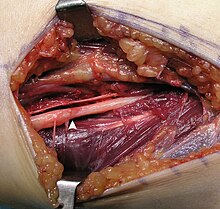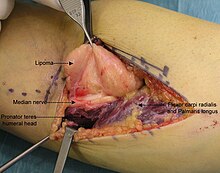Median nerve
The median nerve ("middle arm nerve ", also called median nerve ) is a nerve of the peripheral nervous system . It arises from the brachial plexus . According to this, it has - due to the fiber exchange within the brachial plexus - origins which, with species differences in the individual mammals , range from the 5th neck to 2nd chest segment (in humans up to 1st chest segment) of the spinal cord (C5-Th2 or Th1) .
It runs from the armpit over the inside of the upper arm and then passes under the pronator teres muscle to the palm side of the forearm . In cats (Felidae) it passes through this family's own supracondylar foramen of the humerus .
The median nerve motor innervates the majority of the flexor muscles in the forearm:
- Flexor carpi radialis muscle
- Palmaris longus muscle (human only)
- Musculus flexor digitorum superficialis ( innervated by the ulnar nerve in ungulates )
- Musculus flexor digitorum profundus (except head ulnare)
- Flexor pollicis longus muscle (human only)
- Pronator teres muscle
- Pronator quadratus muscle
- Abductor pollicis brevis muscle
- Musculus flexor pollicis brevis (only caput superficiale)
- Opponens pollicis muscle
- Lumbrical muscles I and II
The nerve pulls through the carpal tunnel onto the palm of the hand. There it innervates some of the short finger muscles. In addition, the median nerve in humans is responsible for the sensitive innervation of the palm from the thumb to the inside of the ring finger.
In the horse , the median nerve forms the two palmar nerves ( lateral and medial palmar nerves ) and is therefore responsible for the entire sensitive innervation of the forefoot, with the ulnar nerve also supplying the outside . These two palmar nerves are sometimes surgically removed (neurectomized) in chronic inflammation of the hoof roller ( podotrochlosis ). In isolated cases there may be a transition from the median nerve to the ulnar nerve; this is called the Berrettini connection.
Diseases
If the median nerve is paralyzed, pronation and flexion of the hand are severely restricted. In humans, the first three fingers can no longer be bent, the thumb is bent towards the back of the hand ("monkey hand"). When trying to flex the fingers, a so-called "oath hand" is created. The index finger is stretched, the middle finger slightly flexed, while the ring and little fingers are flexed (their deep flexor muscles are innervated by the ulnar nerve). In addition, the pain, tactile and temperature sensations of the two thirds of the hand on the thumb side are limited.

Damage in the area near the wrist as a result of carpal tunnel syndrome or cuts (suicide attempt) is more common, as the nerve is relatively superficial directly above the wrist. Then the loss of sensitivity is in the foreground, since the forearm muscles are not affected. In carpal tunnel syndrome, neuralgic pain is also common.
In animals, median paralysis is rather rare and leads to an overstretching of the front toe joints ("patency").
Further clinical pictures associated with the median nerve are the pronator teres syndrome (lesion of the median nerve when it passes through the pronator teres muscle on the forearm - due to forced proc and supination movements of the forearm, compression due to lacertus fibrosus or tendons of the flexor digitorum muscle superficialis ) and the anterior interosseus syndrome (also known as Kiloh-Nevin syndrome , mainly caused by fractures).
literature
- Martin Trepel: Neuroanatomy. Structure and function. 3rd revised edition. Urban & Fischer, Munich et al. 2004, ISBN 3-437-41297-3 .
- Franz-Viktor Salomon: nervous system, systema nervosum. In: Franz-Viktor Salomon, Hans Geyer, Uwe Gille (Ed.): Anatomy for veterinary medicine. Enke, Stuttgart 2004, ISBN 3-8304-1007-7 , pp. 464-577.

